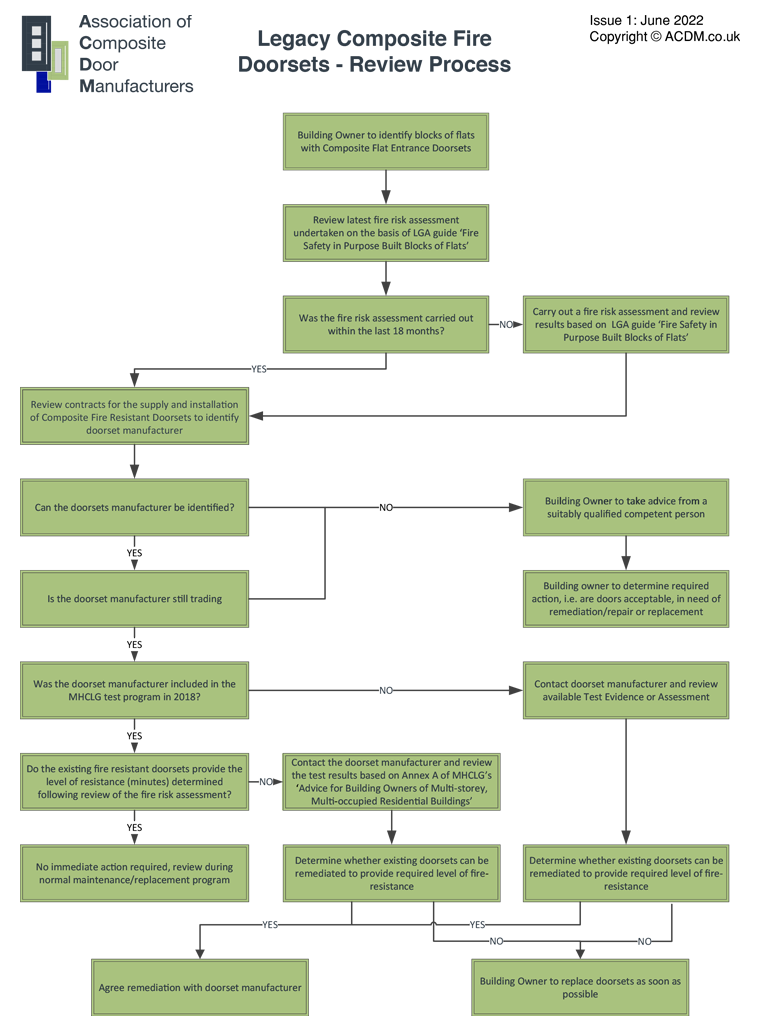Review process following publication of MHCLG Advice NoteReview process following publication of MHCLG Advice Note
Download Full Document Here
Foreword
Following the publication of the MHCLG’s ‘Advice for Building Owners of Multi-storey, Multi-occupied Residential Buildings’ on 20 January 2020, this guide is intended to clarify the process that Building Owners should adopt when reviewing Composite Fire Doorsets installed as flat entrance doors within their properties.
This guide has been developed as part of the work undertaken by the Association of Composite Door Manufacturers in conjunction with MHCLG and is intended to ensure all Building Owners operate a robust process in reviewing occupier safety in accordance with the Consolidated Advice Note, January 2020.
Scope
This guide to Composite Fire Resisting Doorsets is intended to enable Building Owners to assess the flat entrance doorsets installed in their properties prior to May 2018 and is based on:
- The LGA publication ‘Fire Safety in Purpose-Built Blocks of Flats’, published in July 2011 following the Lakanal House fire in July 2009
- MHCLG’s Composite Fire Testing program undertaken in 2018
- Annex A of MHCLG’s ‘Advice for Building Owners of Multi-storey, Multi-occupied Residential Buildings’ published on 20 January 2020
The assessment process basis
Composite Fire Resisting Doorsets installed prior to May 2018, referred to as Legacy Doorsets, should be reviewed following a Risk Assessment carried out as follows:
- Risk assessment carried out by a suitably qualified risk assessor
- The risk assessment should have been carried out within the last 18 months
- The risk assessment observations should be reviewed in accordance with the publication ‘Fire Safety in Purpose-Built Blocks of Flats’ to:
- Determine the length of fire resistance required of the flat entrance doorsets, based on clauses 30, 31 & 32 of Annex A, ‘Advice for Building Owners[1] on assurance and assessment of flat entrance fire doors’, and Appendix A of Annex A.
The Assessment Process
Legacy Fire-Resistant Doorsets installed as flat entrance doors in purpose-built blocks of flats installed prior to May 2018 should be reviewed by Building Owners in accordance with the process detailed below.
- Building Owner to identify those blocks of flats with Composite Fire Resisting Flat Entrance Doorsets that were installed prior to May 2018[2].
- Has a fire risk assessment been carried out in the last 18 months.
- If a fire risk assessment has not been carried out within the last 18 months, a new fire risk assessment should be undertaken by a suitably qualified competent assessor.
- The required duration of resistance to fire should be determined following a recent (in the last 18 months) fire risk assessment and using the guide published by the LGA, ‘Fire Safety in purpose-Built Blocks of Flats’, published in July 2011 following the fire at Lakanal House in 2009.
- Appendix A describes the way in which the LGA guide should be interpreted.
- The fire risk assessor and/or responsible person should refer to ‘Annex A – Advice for Building Owners on assurance and assessment of flat entrance doors’ published by MHCLG on 20 January 2020.
- Refer to clauses 30 to 32 to determine whether single sided testing from the flat side is appropriate.
- Using the flowchart in Annex A, determine the minimum period of fire resistance that is acceptable based on the design/layout of the common areas.
- If single sided testing is appropriate:
- Review the contracts for the installation of the existing doorsets and identify the doorsets manufacturer.
- If the doorset manufacturer can be identified refer to clause 6. below.
- If the doorset manufacturer cannot be identified or if the doorset manufacturer is no longer trading.
- The Building Owner/Responsible person should take advice from a suitably qualified competent person to determine whether the existing doorsets are likely to provide the protection (fire resistance) required.
- If YES, no immediate action is required.
- If NO, the doorsets should be replaced.
- The Building Owner/Responsible person should take advice from a suitably qualified competent person to determine whether the existing doorsets are likely to provide the protection (fire resistance) required.
- Review the contracts for the installation of the existing doorsets and identify the doorsets manufacturer.
- If the doorset manufacturer can be identified and was part of the MHCLG composite fire door investigation in 2018.
- Review the MHCLG test results, the doorset manufacturers test evidence and assessments to determine whether the test reports demonstrate the level of fire resistance required.
- If the level of fire-resistance (minutes) determined in 4.2 above has been shown to have been achieved, no immediate action is required and the doorsets should be assessed during future fire risk and condition assessments.
- Any maintenance issues such as missing or non-working door closers should be addressed by the Building Owner as soon as possibl.e
- If the required level has not been achieved during testing, contact the doorset manufacturer and determine whether remediation can be carried out to provide the level of fire-resistance required
- If remediation is acceptable, agree action required.
- If remediation is not possible, Building Owner to arrange replacement as soon as possible.
- Any maintenance issues such as missing or non-working door closers should be addressed by the Building Owner as a matter of urgency as this issue was found to be significant during the Grenfell Inquiry, Phase 1 report.
- If the level of fire-resistance (minutes) determined in 4.2 above has been shown to have been achieved, no immediate action is required and the doorsets should be assessed during future fire risk and condition assessments.
- Review the MHCLG test results, the doorset manufacturers test evidence and assessments to determine whether the test reports demonstrate the level of fire resistance required.
- If the doorset manufacturer was not included in the MHCLG Composite Fire Door investigation:
- Contact the doorset manufacturer and request the evidence (test evidence and assessments carried out by a UKAS accredited body) on which they based their claims for fire resistance.
- Review the evidence provided and determine whether it supports their claims and whether it meets the requirement determined in 4 above.
- If the evidence is determined to support the above, no immediate action is required and the doorsets should be assessed during future fire risk and condition assessments.
- If the evidence is determined not to support the above, agree with the doorset manufacturer whether remediation is possible.
- If remediation cannot provide the required level of fire-resistance, the doorsets should be replaced as soon as possible.
[1] For the purposes of this document the term ‘building owner’ means the owner of the building or the person, group, company or other entity on whom duties are imposed or enforcement action could be taken under the following legislation: (i) the Housing Act 2004 in relation to certain hazards; or (ii) the Regulatory Reform (Fire Safety) Order 2005 to ensure the safety of occupants of a building from fire (see Articles 3 & 5 of Regulatory Reform (Fire Safety) Order 2005 for those with duties).
[2] Following the MHCLG publication of Advice Note 16 in May 2018, all Composite Fire Resistant Doorsets should have primary test evidence from both sides.
Guidance on need for the upgrading or replacement of flat entrance doors.
- The Local Government Association Guide “Fire safety in purpose-built blocks of flats” recommends that “Notional FD30 doors” (i.e. door assemblies that satisfied the specification, or fire resistance test, for 30 minutes at the time of construction of a block of flats or manufacture of the door) can be accepted in existing purpose-built blocks of flats, provided all other fire precautions are of an acceptable standard.
- However, it is recognised (but accepted) that, because of changes in the fire resistance test, these doorsets would probably achieve no more that 15-20 minutes fire resistance if tested today. It should be stressed that this is not because of any defect in the manufacture of the doors, but is as a result of a change in requirements and the fire resistance test over the years.
- However, there are circumstances in which, as a result of shortcomings in other fire precautions, the LGA guide recommends upgrading of these old doors (by fitting intumescent strips and smoke seals), albeit acknowledging that the doors might not achieve full 30 fire resistance, or replacement of the doorset with a full FD30S certificated doorset.
- This note sets out the circumstances in which replacement or upgrading of the doors is likely to be required for compliance with the LGA guide. This will arise in any one (or more) of three circumstances, namely:
- Excessive travel distance between flat entrance doors and the nearest stairway, so exposing residents to potentially long distance of travel through smoke. This is the most common reason for upgrading or replacement of doors. The reason for this is that, in single stairway buildings prior to 1990, a maximum distance of travel of 15m was accepted, but the maximum distance today is 7.5m. Equally, in many old blocks of flats, fortuitously, the figure of 15m was not reached (e.g. in Grenfell Tower, the maximum distance was around 9m – 10m).
- The absence of any lobby between flats and a single stairway (i.e. flat entrance doors opening directly onto the stairway). This is only acceptable today in small, low rise blocks of flats, but can arise in, for example, old “mansion blocks” in London. Equally, in some of these blocks, because of listed building requirements, the doors cannot be replaced, and an alternative solution, such as installation of a fire alarm system and abandonment of stay put is adopted.
- Blocks of flats with unsatisfactory smoke control arrangements.
Increased travel distance in single stairway buildings: Lobbies without smoke ventilation
- Where there is an unventilated lobby, the maximum distance of travel under current guidance is reduced from 7.5m to 4.5m. However, the LGA guide accepts a distance of up to 6m with no additional measures.
- Where the travel distance is between 6m and 7.5m, upgrading of flat entrance doors is recommended. (Beyond 7.5m, the LGA guide recommends that the lobby should be ventilated, in which case the situation is then as below).
Increased travel distance in single stairway buildings: Lobbies with smoke ventilation
- In this case, the LGA guide accepts a travel distance of up to 10m with no additional measures.
- In lobbies and corridors with a travel distance of 10m – 15m, upgrading of flat entrance doors is recommended.
- Where travel distance is over 15m (which is very unusual), replacement of flat entrance doors is likely to be necessary (along with other measures).
Increased travel distance in multi-stairway buildings
- The current maximum travel distance is 30m. The LGA accepts a figure of up to 40m for existing buildings.
- If the travel distance exceeds 40m (which, in my experience, is virtually unknown), replacement FD30S doors are likely to be necessary.
Flats opening directly onto a single stairway
- The LGA guidance in this case is as follows:
- Up to 4 storeys in height, old doors can remain.
- For 5 and 6 storey buildings, upgraded doors are recommended
- Over six storeys (which will be very uncommon), replacement FD30S doors are necessary.
Inadequate smoke control
- In general, the LGA does not specifically recommend upgrading or replacement doors as a means for compensating for inadequate smoke control. Where necessary smoke control should be improved appropriately. However, it is not impossible that a competent person might recommend upgrading of doors if smoke control cannot be improved adequately. Nevertheless, strictly, the LGA guide does not cater for this situation.

